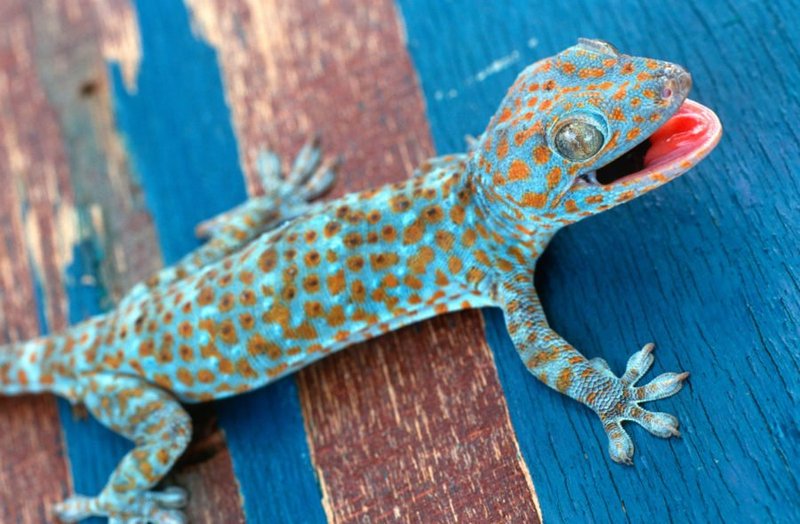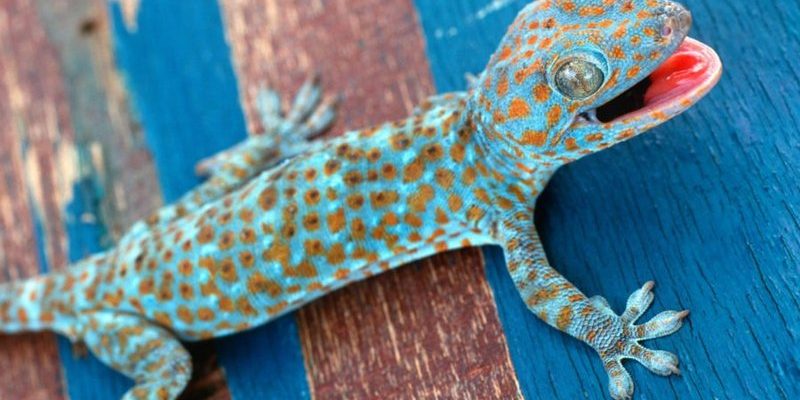
So, what exactly makes the Tokay gecko so special? Think of it like the ultimate problem-solver in a tricky game of survival. If you’ve ever faced a tough challenge and had to find a creative solution, you’ll appreciate how this little creature navigates the obstacles of its world. Let’s dig into the fascinating traits and abilities that help the Tokay gecko not just survive, but thrive.
Vibrant Colors and Camouflage
One of the first things you notice about the Tokay gecko is its stunning colors—bright blue and orange patterns that almost look like they belong in a gallery. But there’s more to those colors than just beauty. The vivid hues serve a purpose, acting as a form of communication. Male Tokay geckos use their colors to attract females and establish territory.
But here’s the thing: those vibrant colors can also act as a double-edged sword. While they might be eye-catching to other geckos, they could draw attention from predators. To counter this, Tokay geckos have an excellent ability to camouflage themselves against various backgrounds, blending into the bark of trees or rocks. This way, they can sneak away from danger while keeping a low profile. It’s like being in a stealth mode when a big challenge comes their way.
Sticky Toes for Climbing
If you’ve ever watched a Tokay gecko scale a wall, you might have marveled at its impressive climbing skills. This gecko is equipped with specialized toe pads that help it grip almost any surface. Each toe has hundreds of tiny hairs called setae that create a strong adhesive effect. It’s not magic; it’s science!
Imagine trying to climb a steep wall without any support—challenging, right? Tokay geckos make it look easy. This adaptation allows them to escape predators, hunt for insects, and navigate their arboreal habitats. They often find themselves high up in trees, where food is plentiful and threats are minimized. Their incredible climbing abilities are a key reason they can thrive in their environment.
Powerful Vocalizations
You might not expect a gecko to be a chatterbox, but the Tokay gecko is known for its loud calls, which can carry over long distances. This vocalization isn’t just for show; it’s a critical survival tool. The males produce a series of distinctive sounds to establish territory and attract mates. Their calls can be so loud and recognizable that they’ve even made their way into local folklore!
Honestly, have you ever heard a Tokay gecko call? It’s a bit like a raucous, repetitive “to-kay, to-kay,” which is where they get their name. These sounds serve as a warning to other males and help them avoid confrontations. Instead of battling it out, a loud call can be enough to stake their claim, keeping them safe while still getting the attention they need.
Strong Defense Mechanisms
When it comes to self-defense, the Tokay gecko has some tricks up its sleeve. One of its most impressive features is its ability to drop its tail when threatened. This might sound dramatic, but losing a tail can distract a predator long enough for the gecko to escape. The tail eventually regenerates—though it won’t look quite the same—offering the gecko a clever way to avoid becoming someone else’s lunch.
Additionally, Tokay geckos can be surprisingly aggressive when cornered. They’re not afraid to bite if they feel threatened, and their jaws can deliver a painful nip. This boldness can deter predators, sending a clear message that they won’t go down without a fight. It’s a fitting example of how their adaptations create a complete survival package.
Dietary Flexibility
Another factor that contributes to the Tokay gecko’s success is its flexible diet. These geckos are primarily insectivores, but they’re not picky eaters. They feast on a variety of food, including crickets, cockroaches, and even small rodents. This adaptability in their diet means they can thrive in diverse environments where food availability might change dramatically.
Imagine being at a buffet with multiple food options—Tokay geckos take full advantage of their surroundings. When prey is scarce, they can switch their menu items without much fuss. This flexibility allows them to survive in various habitats, from lush forests to more urban settings where insects might be abundant.
Resilience to Environmental Changes
The Tokay gecko isn’t just about flashy colors and impressive skills; it’s also incredibly resilient. These geckos can adapt to changes in their environment, whether it’s fluctuations in temperature or alterations in their habitat due to human activity. For example, they can be found in tropical regions, but they’ve also started to thrive in urban areas, showcasing their ability to adjust to new challenges.
You might be wondering how they do it. A combination of behavioral changes and physiological adaptations allows them to cope with different conditions. For instance, they may alter their activity levels based on temperature, becoming more active during cooler nights or less active in extreme heat. This adaptability means they can still find food and reproduce, even when their surroundings become unpredictable.
In the grand tapestry of nature, the Tokay gecko stands out as a remarkable survivor. Its adaptations—like vibrant colors for communication, powerful climbing skills, and flexible dietary habits—paint a picture of resilience and creativity. These little creatures remind us that survival isn’t always about brute strength; sometimes, it’s about clever strategies and a willingness to adapt.
So, the next time you spot a Tokay gecko—perhaps hanging out on a wall or tree—take a moment to appreciate all the ways it has found to thrive in a complex world. Just like us, it’s constantly navigating life’s challenges with a mix of cleverness and charm.

